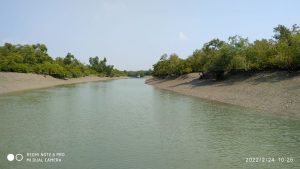

Apart from the human-animal conflict faced by the population dependent on the forest resources for their livelihood, the region is living under the threat of another reality—climate change. Lying in the low coastal zone makes the Sundarbans more vulnerable to the effects of the changing climatic conditions such as floods, cyclones, relative sea-level rise, and coastline erosion. Studies suggest that climate change is leading to increased salinity and higher tidal surges, and permanent submergence of land mass. This results in loss of critical habitat for biodiversity, both fauna and flora.
It has been observed that the surface water temperature in Sundarbans, over a period of 37 years, has increased at an accelerated rate of 5 degree celcius in comparison to global increase in the surface water temperature, which stands at 6 degree celcius . Not only has this adversely impacted the avifauna life, it is proving to be detrimental for the health of the mangrove ecosystem, which is now regenerating at a much lower rate.
There has been a recorded increase in the intensity of cyclonic storms hitting the Sundarbans between 1951 to 2020. Frequent damage to property and crop failure have rendered the population poverty-ridden, inducing increased migration from the region to nearby cities. Low agriculture yield due to erratic rainfall has also contributed to the above.
While human interference such as deforestation in the past years has contributed to the degradation of the forest and increased human-animal conflict; pollution, toxic silt and untreated domestic and industry effluents carried by the rivers downstream has restricted the fresh water supply, causing further loss in the biodiversity of the region . The region also generates considerable amount of waste internally, and in the absence of efficient recycling mechanisms the burden is further increased.




